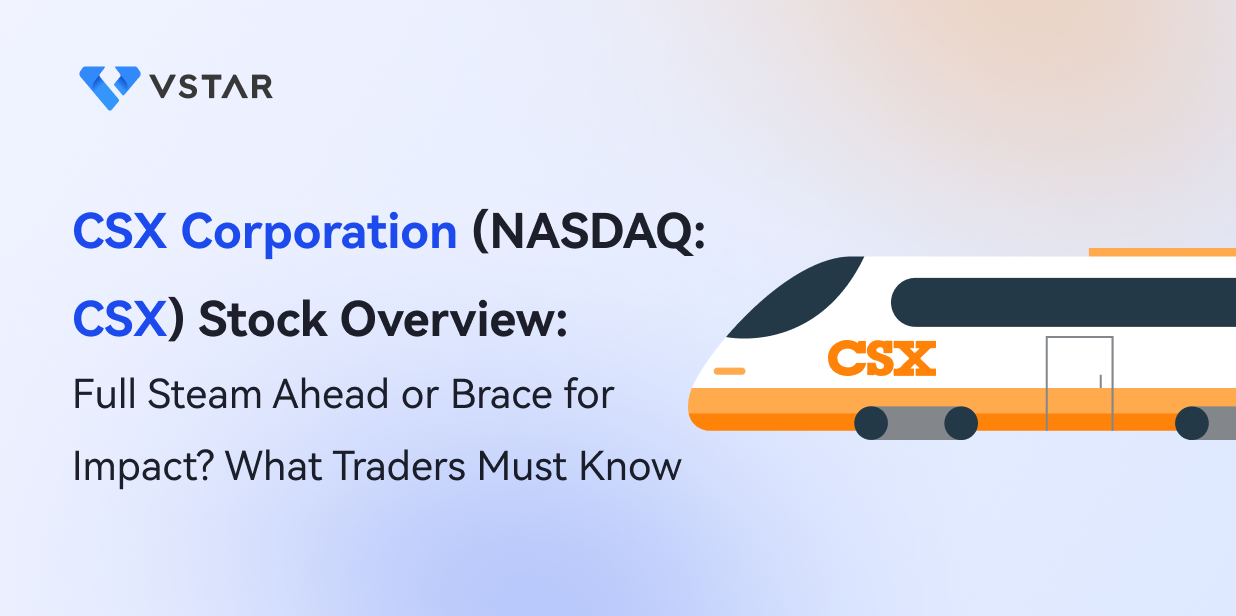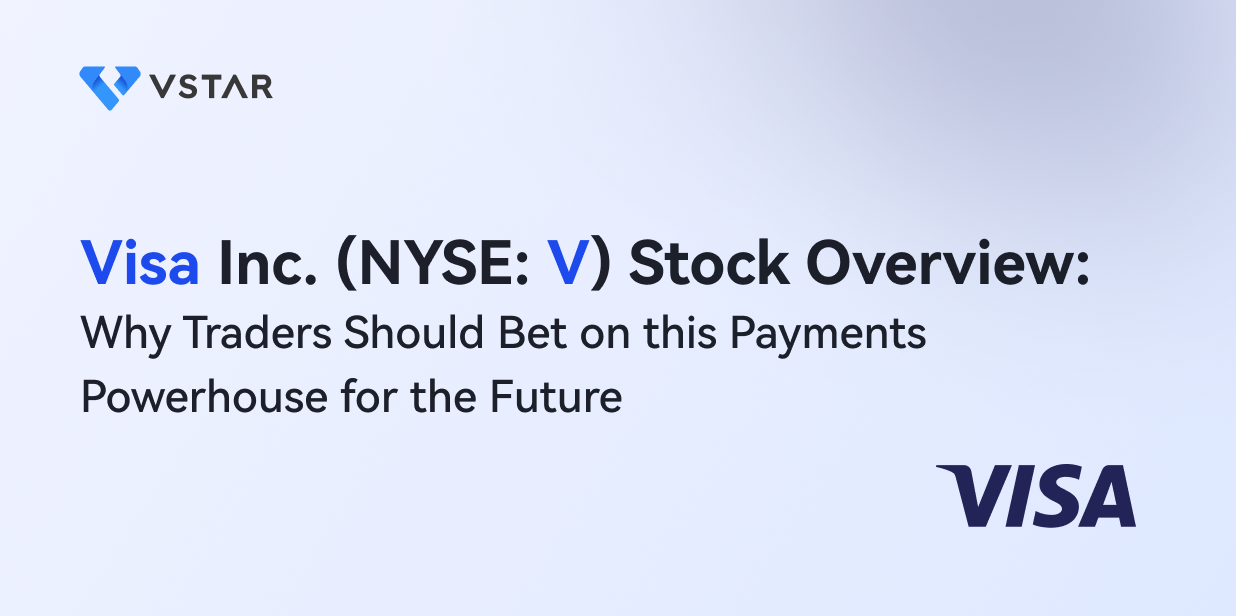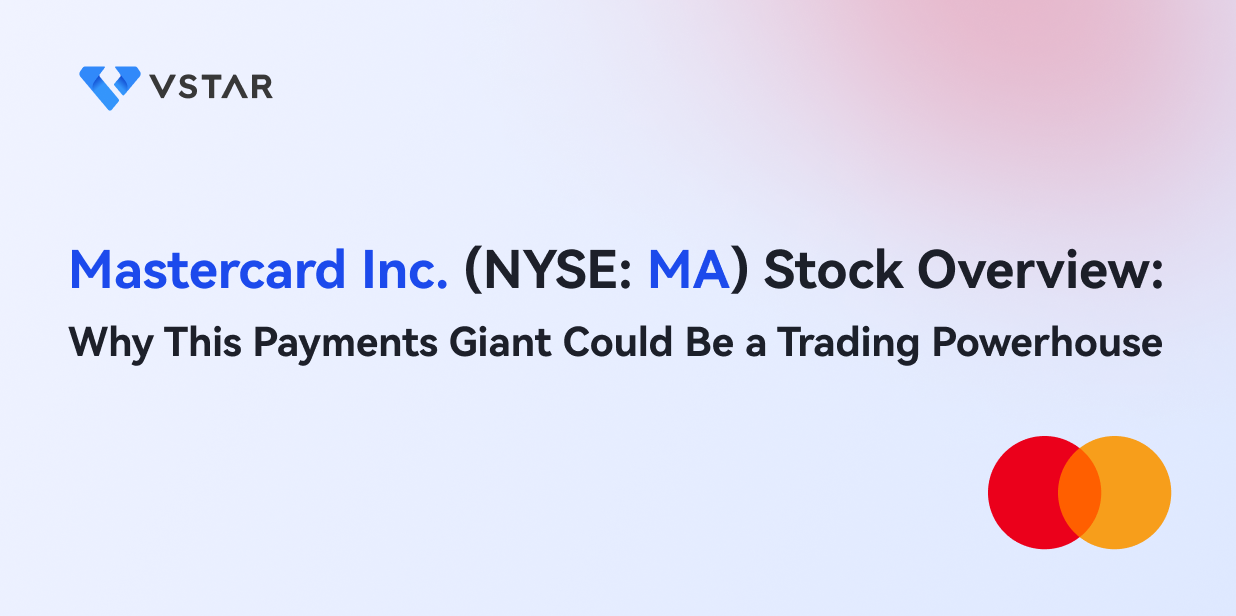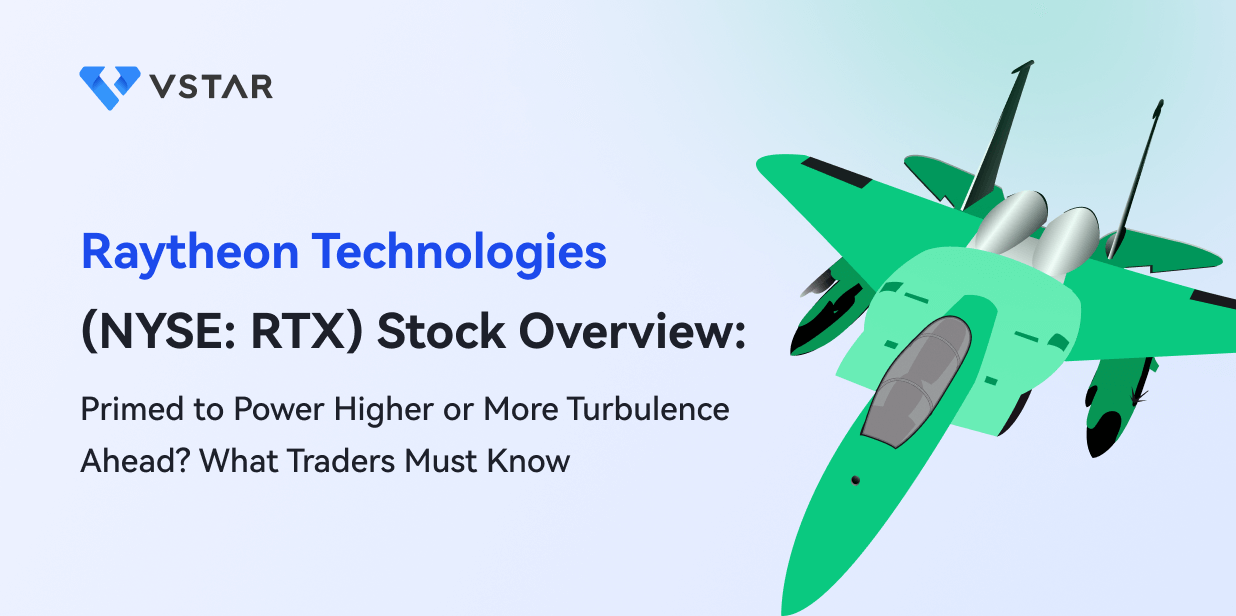CSX Transportation (NASDAQ: CSX) is one of America's leading transportation suppliers. This corporation has consistently demonstrated its crucial role in the economic landscape. In this in-depth stock overview, we shed light on the pivotal factors influencing the trajectory of CSX stock. We scrutinize the current CSX stock price, delve into a comprehensive CSX stock forecast, and navigate this transportation powerhouse's potentially rocky or rewarding rails. We will also introduce you to VSTAR, a fully regulated institutional-level trading platform for CFD trading.
CSX Corporation's Overview
CSX Corporation is one of the leading transportation companies based in the United States. Founded in 1980 due to a merger between Chessie System and Seaboard Coast Line Industries, CSX has grown into a transportation powerhouse. Its headquarters are located in Jacksonville, Florida.
Over the years, CSX Corporation has continued to grow through strategic acquisitions and organic growth, expanding its services across the country. Currently, CSX Corporation has a market capitalization of 62.64 billion USD. Also, as of the quarter ending on March 31, 2023, CSX Transportation’s net income was recorded to be about $0.987B. This translates to a 14.9% increase year-over-year. CSX’s current CEO is Joe Hinrichs.

SOURCE: UNSPLASH
CSX Corporation's Business Model and Products/Services
As mentioned earlier, CSX Corporation is one of the largest rail operators in the Eastern U.S., which has reflected heavily on the CSX stock price. CSX Transportation has built a formidable business model centered on reliability, efficiency, and versatility in freight transport. Straddling over 20,000 route miles of track, the corporation delivers an array of goods vital to a cross-section of industries, including agriculture, automotive, chemicals, military, and energy.
CSX's business model fundamentally involves charging shippers to move their freight across its vast rail network. The corporation employs a 'rail yards' system scattered strategically across the Eastern U.S., where goods are collected, sorted, and then delivered to their respective destinations, ensuring a seamless operation.
CSX has embraced innovation and efficiency, focusing significantly on intermodal transportation. The corporation has also taken several steps to reduce its carbon footprint and promote environmentally-friendly operations. These recent developments could serve as a further catalyst for CSX stock price.
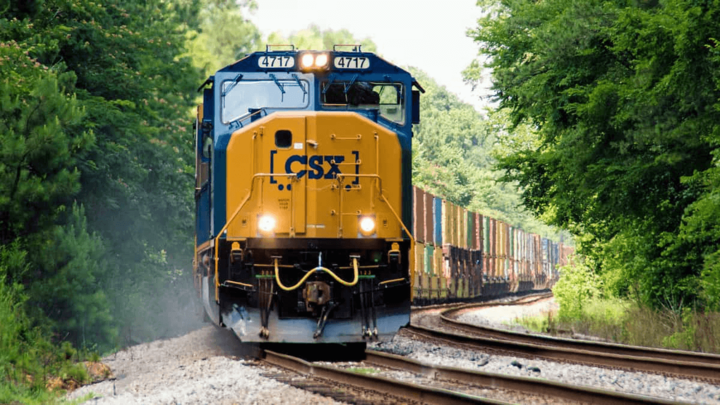
SOURCE: FREIGHT WAVES
Main Products/Services
CSX Corporation offers a range of essential services that form the backbone of its operations. Its main products/services include the following:
1. Intermodal Services: CSX's intermodal services involve leveraging a combination of rail and truck transport. This makes it a valuable player in the supply chain,
2. Carload Shipping: CSX provides traditional train carload shipping for bulk items such as coal, chemicals, and agricultural products.
3. Rail-to-Truck Transloading: The corporation offers trans-loading services for goods requiring both rail and truck transport for their journey.
CSX Transportation also offers the following services:
● TRANSFLO: TRANSFLO is a CSX subsidiary that mainly deals in transferring and handling bulk products alongside logistics management.
● Freight Damage Prevention
● Service Start-Up
● Warehouse Services
● International Connections
The performance of these services plays a vital role in the fluctuation of the CSX stock price and is critical to the stock forecast. Now a question on your mind might be, "Should I buy CSX stock?" A thorough understanding of the above services is required to answer this correctly.
CSX Corporation's Financials, Growth, and Valuation Metrics
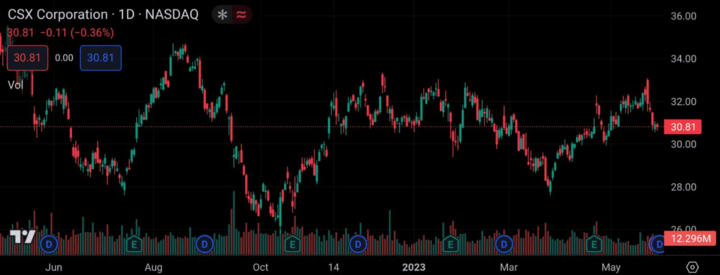
SOURCE: TRADING VIEW
Recent global events, including the COVID-19 pandemic, have significantly impacted the financial growth of many businesses and corporations, with many finding it difficult to stay afloat. For CSX Corporation, however, the story has been one of continued, steady increase.
Over the past five years, CSX’s revenue has steadily grown from $10.583B in 2020 to $15.146B as of March 31, 2023. In this same period, CSX Transportation has recorded a 33% Return On Capital Employed (ROCE) increase. CSX's EBITA margin from December 2018 to 2022 averaged 40.8%. As of March 2023, CSX Transportation’s net profit margin was 28.35%.
Examining the trailing twelve-month metrics from December 2021 to December 2022, CSX's Price to Earnings (PE) ratio sits at 16.0, landing close to its historical average, which hovers around 15. When considering the company's Price to Earnings to Growth (PEG) ratio, which stands at 1.73 for the 12-month forward period, the market value of CSX appears to exceed its anticipated earnings growth, thereby suggesting a less attractive value.
The relatively high PEG ratio signals that CSX is potentially overvalued compared to its future earnings growth. Nonetheless, Wall Street analysts maintain an optimistic view, projecting that CSX's share price could increase to $34.64 by April 21, 2024. However, it's important to note a slight drawback in terms of expected Return on Assets (ROA). CSX's forecasted ROA stands at 9.51%, a notch below the average ROA of 9.66% in the US Railroads industry. This implies that CSX might demonstrate less efficiency in generating profits from its assets compared to its industry peers.
CSX Stock Performance
Before we go into an evaluation of CSX stock forecast and how CSX competitors measure up, let’s take a brief look at some general CSX stock trading information.
CSX Stock Trading Information
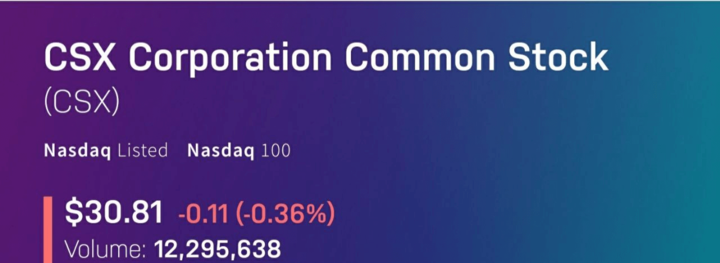
SOURCE: NASDAQ
CSX Corporation stock exchange listing was transferred from the New York Stock Exchange to the NASDAQ global select market after the close of market on December 21, 2015. The ticker symbol for CSX Corporation is "CSX." CSX is a U.S.-based company, and as such, its shares are traded in U.S. dollars. Regular trading hours on the NYSE are from 9:30 a.m. to 4:00 p.m. Eastern Time. Pre-market trading hours for CSX stock are typically from 4:00 a.m. to 9:30 a.m. Eastern Time, while after-market hours are typically from 4:00 p.m. to 8:00 p.m. Eastern Time. However, these hours can vary based on the specific trading platform being used.
CSX stock has undergone a total of five stock splits, with the most recent one happening on June 29th, 2021. This particular stock split, just like the one before it, was a 3-for-1 split. Others have been 2-for-1 splits. CSX has a history of paying dividends to its shareholders since 1990. The last dividend payment to investors was May 30, 2023, with a price of $0.11 per share, and the next payment is scheduled to be done June 15, 2023, with a price of $0.11 per share. The annual CSX dividend payment to investors is $0.44.
Overview of CSX Stock Performance
CSX shares on the NASDAQ have experienced a growth surge of over 10% in recent months. Purchasing CSX at its current rate of $30.81 seems relatively fair, with a minimal downside if the price drops to its actual worth of $28.69. However, considering the expected decline in profit growth of -0.7% over the forthcoming years, short-term growth isn't a compelling reason to buy CSX stock.
What Investors Can Lookout For
Considering CSX stock as a viable purchase? Here are some recent developments you need to be aware of first.
As far as CSX stock price is concerned, the positives far outweigh the negatives. Here are some of the things to look out for:
● CSX experienced a notable 36% uptick in coal revenues in 2022, mainly fueled by a robust export coal sector. Forecast suggests that high prices of export coal and revenues from fuel surcharge will further strengthen the revenue trajectory in the near future.
● CSX Transportation’s merchandise division also shows promising prospects. CSX predicts a modest growth in revenue ton miles in 2023, largely driven by the robust output from the merchandise and coal divisions.
● In addition, CSX has demonstrated its commitment to appreciating its shareholders. The company raised its quarterly dividend by 10% to 11 cents per share in February 2023.
But it’s not all good news. There are also some occurrences that could serve as a potential price risk. Elevated expenses, a result of rising labor costs, outsourced services, and fuel expenses, are putting pressure on CSX's profit margin. In 2021, the company’s total costs saw an 11% year-over-year increase, attributed to 12%, 24%, and 69% rises in labor and benefits costs, outsourced services, and fuel expenses respectively. That said, CSX announced that it has strategically bolstered its workforce to mitigate potential labour scarcity, further underlining its commitment to sustained growth.
Risks and Opportunities

SOURCE: UNSPLASH
CSX stock faces major competition from significant players in the sector, like Union Pacific Corporation (UNP). For example, Both companies are trading at a similar valuation between 4x and 5x trailing revenues. CSX Transportation currently has the better revenue growth, but looking forward, Union Pacific’s revenue is expected to grow faster than CSX’s over the next three years. However, this rapid growth comes with greater risk, lower cash cushion, and a worse debt position. So overall, CSX stock remains the safer, better buy option.
Other Risks
CSX stock ( NASDAQ: CSX) price faces significant threats due to disruptions in the supply chain, primarily triggered by labor and equipment deficits. Further, semiconductor scarcity negatively impacts the Merchandise segment. Potential slowdowns in recovery or industry production, along with labor issues, regulatory challenges, and safety concerns, pose additional risks to the CSX stock price.
Opportunities For Growth and Expansion
CSX Corporation has several growth opportunities that could positively impact its stock price and overall performance. Potential growth areas include investments in efficiency, ports, tracks, and routes. This will boost performance which will, in turn, lead to volume and pricing gains. CSX could also focus on capacity and fleet upgrades aiming to capture volume growth through new routes, terminals, and partnerships.
Future Outlook and Expansion
In the preceding five years, CSX's stock price has demonstrated a consistent upward trajectory, with indicators suggesting a continuation of this trend. Projections suggest a respectable annual growth of 3.8% in earnings and 3% in revenue for CSX. Furthermore, the Earnings Per Share (EPS) are anticipated to see a robust 7.3% rise. It's also expected that the Return on Equity (RoE) will reach an impressive 40.8% in the forthcoming three-year period. CSX has strategically bolstered its workforce to mitigate potential labour scarcity, further underlining its commitment to sustained growth.
How To Invest In CSX Stock

SOURCE: UNSPLASH
Interested in investing in CSX stock but don’t know how to? There are three main ways you can go about this. These include the following:
● Holding The Share
This is a traditional form of investing. It involves directly buying and holding CSX stock of a company. Holding the share allows you to become a partial owner and benefit from any dividends issued and any increase in CSX stock price. However, it requires more capital upfront and exposes you to potential downturns in the stock market.
● Options
Options are financial derivatives that give you the right, but not the obligation, to buy or sell CSX stock at a predetermined price within a specific timeframe. With options, you’ll be able to hedge and leverage your investment. However, options can be complex to understand and use properly. There is also the risk of losing your entire investment if the option expires or becomes worthless.
● Contract for Difference (CFD)
A CFD is a contract between two parties to exchange the difference in the value of an asset (like CSX stock) from when the contract is opened to when it's closed. CFD trading allows you to speculate on price movements without owning CSX stock. The benefits of CFDs include the ability to leverage (meaning you only need a small deposit to open a larger position), the capacity to profit from falling and rising markets, and the possibility to hedge an existing portfolio.
So it’s pretty clear from all three options that trading a CFD is the easiest and safest way to leverage CSX stock. Before you’ll be able to trade CFD, however, you’ll need a CFD provider. It’s important to note that you must choose a reliable CFD provider that offers excellent training conditions and customer service. One such CFD provider is VSTAR. VSTAR is a fully regulated institutional-level trading platform that offers amazing perks like deep liquidity, low trading costs, and lightning-fast execution.
Why Trade CSX Stock CFD With VSTAR
There are numerous benefits to trading CSX stock with VSTAR. Some of these include the following:
1. Competitive Spreads: VSTAR prides itself on offering competitive spreads, keeping trading costs lower for you. So you’ll have access to the best spreads for trading CSX stock.
2. Trade in Any Direction: With VSTAR, you’ll be able to trade CSX stock and benefit from both upward and downward price movements, giving you more trading opportunities.
3. Leverage: With VSTAR, you can maximize your CSX stock trading potential through leverage. This means you can open larger positions with a smaller initial deposit.
4. Professional Customer Support:VSTAR's professional and responsive customer support team is on hand to assist with any queries, ensuring a smooth trading experience.
VSTAR also has an intuitive app designed to accommodate both seasoned traders and novices alike. It comes with key features like a minimum deposit requirement of just $50, protection against negative balances, access to high-demand real-time markets, and the provision of demo accounts for risk-free trading practice.
How To Trade CSX Stock CFD With VSTAR - Quick Guide
● Download the VSTAR app from the App Store or Google Play and register for an account.
● Deposit funds using your preferred payment method. You can choose between Visa, Mastercard, Tether, Skrill, Netteller, SticPay, or Perfect Money.
● Search for CSX stock in the app and tap on it to open the trading screen.
● Choose your trade size, leverage, stop loss, and take profit levels.
● Based on your market analysis and expectations, decide whether you want to buy (go long) or sell (go short) CSX stock CFD.
● Confirm your trade and monitor your position until you close it or it reaches your stop loss.
Conclusion

SOURCE: iStock
Trading CSX Corporation (NASDAQ: CSX) stock has the potential for significant rewards and risks. From supply chain disruptions to new growth opportunities, the factors influencing CSX's future are numerous and varied. As investors, it's crucial to stay informed about these factors and understand how they could impact CSX's stock price. However, now that you’re armed with knowledge and a keen eye on market trends, you can make informed decisions that align with your investment strategies and risk tolerance. Download the VSTAR app today to get started with CSX stock trading.
